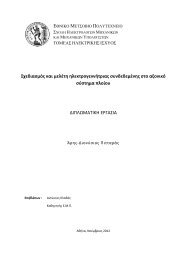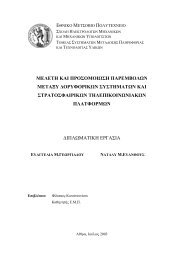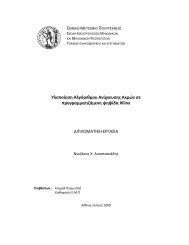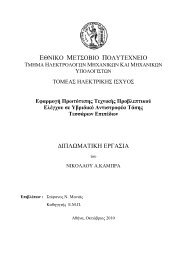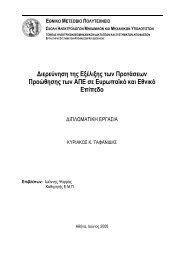ÎÎÎ ÎΩÎÎΤÎÎÎ ÎΡÎÎΣÎÎ
ÎÎÎ ÎΩÎÎΤÎÎÎ ÎΡÎÎΣÎÎ
ÎÎÎ ÎΩÎÎΤÎÎÎ ÎΡÎÎΣÎÎ
You also want an ePaper? Increase the reach of your titles
YUMPU automatically turns print PDFs into web optimized ePapers that Google loves.
Abstract<br />
Purpose of this Diploma Thesis is the analysis of the leakage ground current shown in<br />
photovoltaic systems connected to the grid due to the lack of an isolation transformer. The<br />
two main factors affecting the amplitude and the frequency spectrum of leakage currents are<br />
the technology of photovoltaic modules and the chosen inverter topology. Topologies such as<br />
the Full Bridge, NPC etc. are investigated and compared in terms of the leakage currents in<br />
the rest of this thesis.<br />
More specifically, the first chapter sets out the reasons for omitting the isolation<br />
transformer in modern photovoltaic systems and analyzes the factors affecting the value of the<br />
parasitic capacitance and therefore the value of the ground currents.<br />
The second chapter describes the simplified equivalent circuit of the photovoltaic<br />
generator. It also presents all the inverter topologies that will be developed and explored in<br />
terms of leakage currents and analyzes the harmonic components of output voltage and output<br />
current of each topology. Furthermore, the function of the dc/dc boost converter and the<br />
frequency response of the LC filter are being studied.<br />
The third chapter analyzes all the individual control systems that are necessary for the<br />
proper functioning of the entire PV system. Specifically, both current control techniques: PI<br />
control and Hysteresis control are being studied. It also describes the operation of Phase<br />
Locked Loop and Maximum Power Point Tracking devices.<br />
In the fourth chapter, the simulation results are presented, the leakage currents are<br />
analyzed in terms of their harmonic content and different inverter topologies are being<br />
compared. A complete model of the solar system was implemented with the help of the<br />
designing program PSpice.<br />
Computer simulations are followed by experimental measurements on a grid<br />
connected photovoltaic system installed at the National Technical University of Athens. The<br />
experimental results are in the fifth chapter.<br />
In the final chapter, conclusions of the study are drawn and ideas for future research<br />
are being suggested.<br />
Key Words<br />
Photovoltaic (PV), parasitic capacitance, leakage current, common mode analysis, galvanic<br />
isolation, transformer – Transformerless (TL), inverter.<br />
iii




